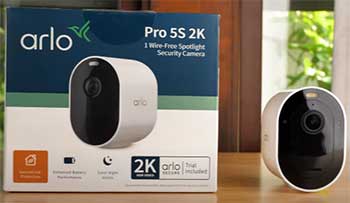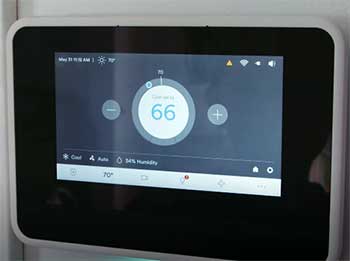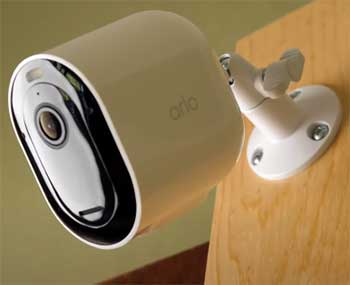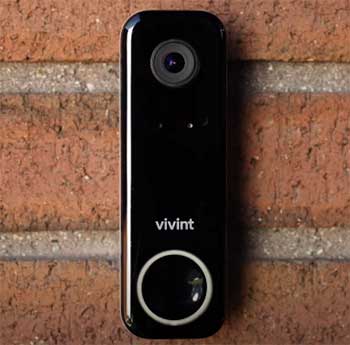Home security has come a long way from being restricted to wired sensors and alarms. Today’s security systems integrate intelligent monitoring with smart home devices and mobile connectivity.
Vivint and Arlo are two of the top brands offering modern smart security solutions tailored for safety-conscious yet tech-savvy homeowners.
Both systems have wireless capabilities, smart home integrations, mobile apps and professional monitoring options. However, there are some major differences when it comes to features, installation process, contracts and overall value.
This comprehensive guide will compare Arlo and Vivint head-to-head so you can determine which system meets your specific home security needs.
Key Differences At A Glance
| Features | Arlo | Vivint |
| Equipment Ownership | Customer owned | Company owned |
| Contracts | No long-term contract | 42-60 month contract |
| Installation | DIY or professional | Professional only |
| Monitoring Plan | Optional plan | Mandatory for equipment |
| Smart Home Capabilities | Works with Amazon, Google & Apple ecosystems | Proprietary platform only |
| Video Storage | Local and cloud options | Cloud only |
| Mobile App | Intuitive with automation options | Laggy with basic controls |
| Outdoor Camera Image Quality | Clear 1080p video | Grainy 720p video |
| False Alarm Rate | Very low with intelligent motion detection | Higher without camera analysis |
Equipment, Installation and Contracts
One major area where Arlo and Vivint differ significantly is equipment fees, installation and contacts…
- Arlo Equipment and Installation

Arlo sells its system outright without any long-term service contracts.
You fully own the Arlo base station, cameras and sensors without needing to lease the equipment or return it later.
With flexible magnetic and adhesive mounts, Arlo devices are designed specifically for DIY installation.
You can easily place cameras, sensors and lights anywhere inside or outside your home without wiring or drilling holes. If you prefer help setting up, Arlo’s professional assistance is available as a one-time fee.
Without any multi-year service agreements, Arlo gives you the freedom to pay annually, monthly or not at all for professional monitoring. There are also no hidden fees or termination penalties for canceling monitoring later.
- Vivint Equipment and Installation
Unlike DIY-friendly Arlo gear, Vivint uses a traditional security system model with long-term contracts covering leased equipment. Vivint technicians handle the entire setup process start to finish.
While pro installation guarantees quality, it also locks you into a multi-year contract just to access features and eliminate fees. Vivint requires professional service plans ranging between 42-60 months.
You must return all leased Vivint devices after cancelling monitoring or the company will charge you full prices exceeding $1000 or more. Breaking contracts early also incurs termination fees upwards of $700.
Smart Home Integration
Both Arlo and Vivint can integrate with other smart home devices, but there are major platform differences that impact overall compatibility.
- Arlo’s Open Platform with Seamless Automation
A standout advantage of Arlo is how it operates on an open platform model. Rather than limiting ecosystem partnerships, Arlo designs products for interoperability with smart homes powered by Amazon Alexa, Google Assistant and Apple HomeKit.
With flexible API development options, over 140 third-party brands also integrate with Arlo natively to enable truly automated actions. You can set up scenes and schedules to trigger cameras, lights, locks, switches, sensors and more based on customizable rules.
For instance, an Arlo camera detecting motion by the front door after sunset can automatically turn on porch lights and record video without any input needed from you.
- Vivint’s Proprietary Platform Lacks Flexibility

On the other hand, Vivint utilizes a single proprietary platform that only natively supports its own brand of devices and software.
The only exception is enabling basic Amazon Alexa or Google Assistant voice controls for arming, disarming and checking status.
Without open standards, you miss out on setting up advanced automations that leverage other smart products and brands you might own. Vivint forces you into its closed hardware environment without options to incorporate third-party cameras, sensors and accessories.
The Vivint app itself also lacks flexible scheduling and scenes to trigger automatic actions. You only get basic modes like Home and Away instead of location tracking, facial recognition triggers and custom rules.
Video Storage: Local Vs. Cloud-Only
A security system without reliable access to video recordings provides little accountability or forensic evidence should any incidents occur. That’s why storage options are essential to consider when choosing between Arlo or Vivint.
- Arlo Supports Both Local and Cloud Storage
Arlo understands the value its customers place on keeping video recordings safe, accessible and in their direct control at all times. That’s why Arlo natively supports both local and cloud storage options.
For local storage, Arlo’s wireless base stations provide USB ports to connect external hard drives and store recordings in your home without any monthly fees. Cloud plans give you 30 days of addon storage as needed for extra convenience.
You don’t have to decide between choosing either local or cloud storage. Arlo makes it easy to simultaneously enable both according to your specific backup needs and budget. No recordings are ever held hostage if you ever suspend or terminate services.
- Vivint Limits Video Accessibility with Cloud-Only Storage
Vivint heavily promotes its “DVR service” when comparing its system directly against Arlo. However, the Vivint DVR plan simply includes a mandatory $10/month cloud subscription to enable any recording functionality at all. Without paying, cameras won’t capture clips when detecting motion or activity.
There is simply no local storage option with Vivint — the only way to store and retrieve video from Vivint cameras is by paying for an ongoing cloud access plan. Miss a monthly bill and your recordings immediately become inaccessible.
If you ever choose to cancel service after ending a contract, Vivint can revoke cloud storage access. Years worth of cloud recordings could instantly disappear by terminating account credentials.
Mobile App Platform Differences
Controlling your security system directly from your smartphone provides convenience along with peace of mind. Comparing the Arlo vs Vivint mobile apps reveals major advantages in platform support, UI design and overall functionality.
- Arlo’s Sleek App with Robust Feature Set

As previously highlighted, Arlo’s multi-platform app supports Android, iOS, Fire OS and web login access.
The modern interface lays out camera feeds, modes, settings and automations accessibly within the intuitive Arlo app dashboard.
Smooth navigation combined with 2-way talk, automated geo-fencing and manual touch controls gives Arlo app a highly-polished user experience.
Helpful timeline video search tools also make it effortless to scrub through historical motion events.
You always have full administrative and viewer access permissions without any feature or module restrictions within the mobile platform.
- Clunky Vivint App Lacks Polish and Controls
Vivint users frequently complain about the clunky Go! Control app with latency issues, constant buffering, crashes and limited functionality. Significant platform restrictions also segment out critical security controls from mobile access.
While Vivint promises full integration, the disappointing app execution delivers a fractured, frustrating user experience. Strategically important settings and options remain locked inside the installer backend tools inaccessible to end customers.
Instead of providing self-service access, Vivint deliberately segments out administrative controls that force customers to pay $49 technician fees for basic account changes. And unlike Arlo, you cannot add users or share access to cameras without incurring more monthly monitoring plan charges.
Alarm Monitoring and Emergency Response
Both Arlo and Vivint offer optional professional alarm monitoring with emergency response by partner security providers, including Cops, Brinks Home Security and MONI. However, there are alert dispatch differences between the two platforms.
- Arlo Monitoring Dispatch Based on Visual Verification
Arlo says its Alarm.com partnership for professional monitoring allows operators to “confirm what’s really happening” before dispatching emergency responders to your home.
Enabled by access to view Arlo’s crystal clear camera feeds in real-time, monitoring agents can visually identify criminal threats to distinguish from false alarms avoided. Tighter integration between live video streaming and alarm sensors helps Arlo’s monitoring partners significantly reduce costly false dispatches.
- Higher Vivint False Alarms Without Camera Verification
Unlike Arlo’s camera-informed monitoring, Vivint relies solely on sensors to detect threats. Without actually seeing criminal activity taking place, Vivint tests show its system generates higher rates of false alarms plaguing much of the home security industry.
Higher false alarm rates lead police departments to start fining homeowners mandatory fees. And some municipalities like Salt Lake City have stopped responding to new Vivint customer addresses due to excessive false dispatches burning out emergency response resources.
Camera Comparison: Image Quality and False Alerts
Evaluating security camera footage quality and motion detection accuracy plays a major role when comparing Arlo vs. Vivint systems. Achieving balance between capturing important activity while minimizing false alerts takes video technology innovations only Arlo seems to demonstrate.
- Arlo Camera Captures Crystal Clear 1080p Video
Arlo Ultra 2 and Pro 4 camera models utilize advanced 4K sensors supporting full 1080p HD recording. Capturing fine details like facial characteristics, clothing logos and vehicle license plates assists criminal investigations.
Color night vision gives Arlo cameras the unique advantage to record video in full color, even in low to no light conditions. This helps identify suspicious activity in dark environments conventional IR night vision would overlook.
- Vivint Cameras Record Grainy 720p Footage

In contrast, Vivint only supports 720p recording quality with inferior components prone to motion blur, blown-out exposures and grainy night shots.
Dull black-and-white night vision fails to provide identifiable suspect features for authorities responding a reported incident at your property.
Without higher resolution color sensors, Vivint cameras become virtually unusable for live monitoring.
And good luck trying to submit video evidence to investigators when footage lacks clear identifiable details.
- Arlo AI Optimizes Motion Notifications, Minimizes False Alerts
The most frustrating aspect of any security system remains motion sensors triggering endless false alerts by plants blowing, animals passing or vehicles driving by routinely throughout the day.
Arlo actively combats this nuisance by equipping cameras with AI computer vision able to intelligently distinguish between actual threats and non-issues. People and vehicle detectors have advanced machine learning algorithms minimizing unnecessary notifications.
You enjoy dramatically fewer interruptions while maintaining responsive alerting when strangers approach doors or meander around property unusually. Arlo cameras also use auto zoom and tracking to keep suspicious subjects centered in view automatically.
- Basic Vivint Alerts Lead to More Nuisance Notifications
Like most traditional security systems, Vivint relies solely on basic motion and impact sensors without visual context to validate potential threats before pushing alerts. Unable to determine threats visually, Vivint sends notifications to homeowners constantly as cars drive by routinely or pets wander around regular paths.
With no ability to teach Vivint sensors about common environmental activity, you remain vulnerable to alarm fatigue from excessive alerts overwhelming actual situations needing a response. Eventually users start disregarding notifications as unreliable, thereby missing events requiring an active alert.
Professional Monitoring Service Options
Both Arlo and Vivint make professional alarm monitoring available to dispatch emergency responders and contact you when sensors detect potential home intrusions. But there are big distinctions in how plans work between the two platforms.
- Arlo Monitoring – No Long Term Contracts Required
As reinforced throughout our Arlo vs Vivint comparison, a major perk built into Arlo’s monitoring plans provides the flexibility to enable and disable services anytime without requiring long multi-year contracts or early termination fees.
That freedom remains consistent with optional alarm monitoring through Alarm.com operators starting at $19.99 per month. When traveling away from home for extended periods where monitoring becomes unnecessary, for example, you have the unique ability to simply pause the plan temporarily and resume later just for added peace of mind when living in your residence routinely.
- Mandatory Vivint Monitoring Under Contract
Given how Vivint makes customers lease equipment under mandatory multi-year commitments, it comes as no surprise that alarm monitoring follows the same structure locking users into long term plans with penalties.
Minimum 3-5 year Vivint monitoring agreements become required simply to power on system gear after completing initial installations. Without maintaining continuous services billed monthly around $30-50 or more, Vivint equipment otherwise won’t even function at all.
Vivint intentionally bridges security hardware and monitoring together, so terminating one disables the other. Also, home insurance discounts offered for signing these longterm contracts often fail to balance out the excessive overall equipment and monthly costs accumulated.
Frequently Asked Questions (FAQ)
No major security camera brand on the market currently exceeds Arlo’s unique combination of completely wireless DIY installation, flexible local storage support, ultra sharp 4K video quality, free basic cloud recording and multi-platform interoperability with leading smart home ecosystems.
Arlo continues leading the connected camera category without requiring long-term contracts. Ongoing innovations ensure Arlo maintains its standing as the premier, top-rated consumer security system.
The few disadvantages of choosing Arlo over competitors include:
1. Battery-powered cameras require occasional charging
2. Shorter Arlo Smart cloud storage history compared to local HDDs
3. Base station range limitations in remote wilderness areas
Overall, Arlo compensates for any modest limitations with outstanding advantages and value balancing out the total cost of ownership.
Absolutely not! Arlo remains solidly committed to advancing smart security solutions well into the future. Recent Arlo community updates confirm significant R&D investments fueling a promising roadmap of product launches over years ahead.
In 2022 alone, Arlo unveiled its 4K Ultra 2, Pro 4 Wire-Free spotlight and floodlight camera models to universal acclaim for premium performance upgrades. More exciting Arlo innovations undoubtedly lie ahead.
No. As a closed platform built strictly around proprietary devices, Vivint systems provide no open API for Arlo cameras or other third-party smart home products to directly integrate for unified control solutions.
You would need to use two separate apps and miss out on robust automation benefits from Arlo’s native compatibility across 100+ leading smart home brands competing with Vivint on flexibility.
Closing Remarks
When comparing Arlo vs Vivint overall as comprehensive home security solutions, the differences strongly favor Arlo’s open platform approach aligning with smart home innovations commanding current consumer preferences.
Vivint still operates around an increasingly outdated model – forcing multi-year equipment leases and monitoring contracts just to unlock available offerings.
In contrast, Arlo allows you to choose flexible monitoring terms or even skip professional services completely to self-monitor DIY systems owned outright without hidden fees down the road.
Focusing investment in advanced smart detection separates Arlo quality even further from Vivint’s reliance on more traditional motion-triggered alerts without visual verification. Analysis shouldn’t require contracts. Only Arlo provides that peace of mind built-in.
Ready to Protect Your Smart Home with Arlo?
